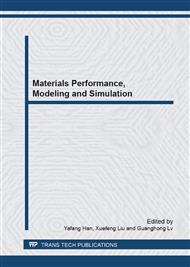[1]
Information on http: /www. itrs. net/Links/2008ITRS/Home2008. htm.
Google Scholar
[2]
M. J. Kumar, A. A. Orouji, Two-dimensional analytical threshold voltage model of nanoscale fully depleted SOI MOSFET with electrically induced S/D extensions, IEEE Trans. Electr. Dev. 52 (2005) 1568-1575.
DOI: 10.1109/ted.2005.850624
Google Scholar
[3]
K. S. Novoselov, A. K. Geim, S. V. Morozov, D. Jiang, Y. Zhang, S. V. Dubonos, I. V. Grigorieva, A. A. Firsov, Electric field effect in atomically thin carbon films, Science 306 (2004) 666.
DOI: 10.1126/science.1102896
Google Scholar
[4]
W. Choi, I. Lahiri, R. Seelaboyina, Y.S. Kang, Synthesis of graphene and its Applications: A review, Crit. Rev. Solid State Mater. Sci. 35 (2010) 52-71.
DOI: 10.1080/10408430903505036
Google Scholar
[5]
Y. M. Lin, C. Dimitrakopoulos, K. A. Jenkins, D. B. Farmer, H. Y. Chiu, A. Grill, P. Avouris, 100-GHz transistors from wafer-scale epitaxial graphene, Science 327 (2010) 662.
DOI: 10.1126/science.1184289
Google Scholar
[6]
G. Cocco, E. Cadelano, L. Colombo, Gap opening in graphene by shear strain, Phys. Rev. B 81 (2010) 241412.
DOI: 10.1103/physrevb.81.241412
Google Scholar
[7]
X. G. Liang, Y. S. Jung, S. W. Wu, A. Ismach, D. L. Olynick, S. Cabrini, J. Bokor, Formation of bandgap and subbands in graphene nanomeshes with sub-10 nm ribbon width fabricated via nanoimprint lithography, Nano Lett. 10 (2010) 2454-2460.
DOI: 10.1021/nl100750v
Google Scholar
[8]
Y. W. Son, M. L. Cohen, S. G. Louie, Energy gaps in graphene nanoribbons, Phys. Rev. Lett. 97 (2006) 216803.
DOI: 10.1103/physrevlett.98.089901
Google Scholar
[9]
C. Lee, X. D. Wei, J. W. Kysar, J. Hone, Measurement of the elastic properties and intrinsic strength of monolayer graphene, Science 321 (2008) 385-388.
DOI: 10.1126/science.1157996
Google Scholar
[10]
E. Cadelano, L. P. Palla, S. Giordano, L. Colombo, Nonlinear elasticity of monolayer graphene, Phys. Rev. Lett. 102 (2009) 235502.
DOI: 10.1103/physrevlett.102.235502
Google Scholar
[11]
S. Plimpton, Fast parallel algorithms for short-range molecular dynamics, J. Com. Phys. 117 (1995) 1.
Google Scholar
[12]
S. J. Stuart, A. B. Tutein, J. A. Harrison, Effects of monolayer disorder on the friction of anchored alkane chains, J. Chem. Phys. 112 (2000) 6472-6486.
Google Scholar
[13]
D. W. Brenner, O. A. Shenderova, J. A. Harrison, S. J. Stuart, B. Ni, S. B. Sinnott, A second-generation reactive empirical bond order (REBO) potential energy expression for hydrocarbons, J. Phys. Condens. Matter. 14 (2002) 783-802.
DOI: 10.1088/0953-8984/14/4/312
Google Scholar
[14]
Q. X. Pei, Y. W. Zhang, V. B. Shenoy, A molecular dynamics study of the mechanical properties of hydrogen functionalized graphene, Carbon 48 (2010) 898-904.
DOI: 10.1016/j.carbon.2009.11.014
Google Scholar
[15]
O. A. Shenderova, D. W. Brenner, Atomistic modeling of the fracture of polycrystalline diamond, Phys. Rev. B 61 (2000) 3877-3888.
DOI: 10.1103/physrevb.61.3877
Google Scholar
[16]
H. Zhao, K. Min, N. R. Aluru, Size and chirality dependent elastic properties of graphene nanoribbons under uniaxial tension, Nano Lett. 9 (2009) 3012-3015.
DOI: 10.1021/nl901448z
Google Scholar
[17]
G. Cocco, E. Cadelano, L. Colombo, Gap opening in graphene by shear strain, Phys. Rev. B 81 (2010) 241412.
DOI: 10.1103/physrevb.81.241412
Google Scholar
[18]
J. Zhou, R. Huang, Internal lattice relaxation of single-layer graphene under in-plane deformation, J. Mech. Phys. Solids 56 (2008) 1609-1623.
DOI: 10.1016/j.jmps.2007.07.013
Google Scholar
[19]
F. Ma, Y. J. Sun, D. Y. Ma, K. W. Xu, P. K. Chu, Reversible phase transformation in graphene nano-ribbons: Lattice shearing based mechanism, Acta Mater. 59 (2011) 6783-6789.
DOI: 10.1016/j.actamat.2011.07.036
Google Scholar



